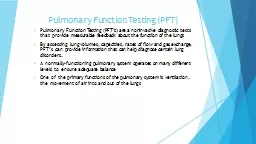

Pulmonary Function Testing PFTs are a noninvasive diagnostic tests that provide measurable feedback about the function of the lungs By assessing lung volumes capacities rates of flow and gas exchange PFTs can provide information that can help diagnose certain lung disorders ID: 479321
Download Presentation The PPT/PDF document "Pulmonary Function Testing (PFT)" is the property of its rightful owner. Permission is granted to download and print the materials on this web site for personal, non-commercial use only, and to display it on your personal computer provided you do not modify the materials and that you retain all copyright notices contained in the materials. By downloading content from our website, you accept the terms of this agreement.
Slide1
Pulmonary Function Testing (PFT)
Pulmonary Function Testing (PFT’s) are a noninvasive diagnostic tests that provide measurable feedback about the function of the lungs
By assessing lung volumes, capacities, rates of flow and gas exchange, PFT’s can provide information that can help diagnose certain lung disorders.
A normally-functioning pulmonary system operates on many different levels to ensure adequate balance
One of the primary functions of the pulmonary system is ventilation, the movement of air into and out of the lungs Slide2
Pulmonary Function Terms
Tidal volume (VT).
This is the amount of air inhaled or exhaled during normal breathing
Minute Volume (MV).
This is the total amount of air exhaled per minute.
Vital capacity (VC).
This is the total volume of air that can be exhaled after maximum inspiration
Functional residual capacity (FRC).
This is the amount of air remaining in lungs after normal expiration
Total lung capacity.
This is the total volume of lungs when maximally inflated
Forced vital capacity (FVC).
This is the amount of air exhaled forcefully and quickly after maximum inspiration
Forced expiratory volume (FEV).
This is the volume of air expired during the first, second, and third seconds of the FVC test. FEV1 is obtained from this measurement
Forced expiratory flow (FEF 25-75%).
This is the average rate of flow during the middle half of the FVC test
Peak expiratory flow rate (PEFR).
This is the maximum volume during forced expiration.Slide3
Pulmonary Function Test (PFT’s)
Spirometry
Some PFT’s involve the use of a spirometer
The Spirometer is an instrument that measures the amount of air breathed in and out and how quickly the air is inhaled and expelled from the lungs while breathing through a mouthpiece
The measurements are recorded on a device called a
spirographSlide4
Reasons for the PFT Procedure
Allergies
Chronic lung infections
Asbestosis
Chest Trauma
Restrictive airway conditions
Respiratory infections
Sarcoidosis
SclerodermaSlide5
Most common parameters measured in spirometry
Vital capacity (
VC)
. This is the total volume of air that can be exhaled after maximum
inspiration
Forced Vital Capacity (FVC). This is the amount of air exhaled forcefully and quickly after maximum inspiration
Forced Expiratory Volume (FEV
1).
This is the volume of air expired during the
first second
of the FVC test
Forced Expiratory Flow (FEF
25-75%).
This is the average rate of flow during the middle half of the FVC testSlide6
Pulmonary Function Testing (PFT’s)
Results are usually given in both raw data and percent predicted
The test results as a percent of the “predicted values” for the patients of similar characteristics (Height, age sex and sometimes race and weight)Slide7
Pulmonary Function Test (PFT’s)